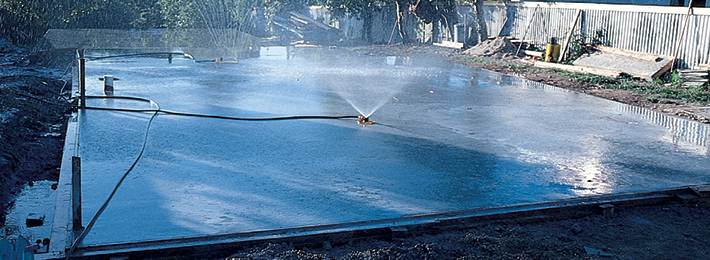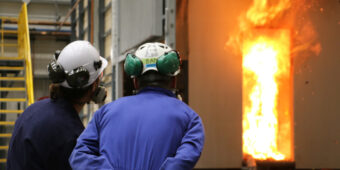Curing concrete correctly
13 Feb 2017, Building and housing, Featured, Prove Your Know How, Technical

Relieve the pain of a bad finish by ensuring you’re curing concrete correctly
Almost without exception, technical specifications call for concrete to be cured; however, the process is not always undertaken correctly.
Why cure concrete?
Curing is the name given to procedures that promote the hydration of cement. The following focuses on the control of moisture movement, although temperature control is also needed.
When water is added to cement, a complex chemical reaction occurs which hydrates the cement and, in time, produces a firm, hard mass. This reaction continues when water is present. If the water is removed, the reaction stops, which results in the cement being only partially hydrated.
Concrete is therefore cured to control the rate and extent of moisture loss during cement hydration.
What are the advantages?
Moisture loss from the surface of concrete has the potential to impact on strength and durability, and cause early-age cracking.
The strength of concrete is predominantly determined by the water/cement ratio and the degree of hydration. If premature drying occurs, the hydration process will stop and the desired strength of the concrete will not be attained.
To appreciate this, it’s useful to visualise the chemical reaction of cement and water as a process whereby thin needles begin to grow out of each grain of cement after water is added.
As these needles grow, they become intertwined and it’s this interlocking process that gives concrete its strength. If the water dries up, the needles stop growing and less intermeshing occurs, resulting in loss of strength.
Therefore, inadequate curing can result in a weak concrete surface, which may wear under the abrasive action of traffic. Curing will also impact on the ability of the concrete to protect the reinforcement from corrosion.
The longer that water is present, the more intertwined the cement needles will become and the denser the concrete cover will be. This will make the concrete cover more watertight, increasing the time it takes before conditions around the reinforcing bar cause corrosion.
Another important feature of curing is its impact on the potential for early-age cracking, which occurs when tensile stresses in concrete exceed tensile strength. Tensile stresses can develop in the surface of concrete when the top dries and starts to shrink, while the saturated core of the concrete resists against the surface.
If curing doesn’t commence as early as possible, moisture can escape from the pores of the concrete near the surface. This creates negative pressure in the capillaries, causing the solid particles to draw closer together (shrinkage). If curing prevents moisture escape, surface shrinkage will be avoided and the concrete is given the chance to gain some strength with time.
What are the options available?
Methods of curing concrete fall broadly into the following:
• Those that minimise moisture loss from the concrete by covering them with relatively watertight membranes.
• Those that prevent moisture loss by continuously wetting the surface.
Which is best?
This depends on the project; however, a few things to keep in mind are:
• If using water curing, the surface must be kept continuously moist. Ensure that run-off water doesn’t enter streams or the storm water system, as it may have an adverse effect on aquatic life.
• Curing with polythene may result in some discolouration of the surface. The effectiveness of this curing method is greatly reduced if it’s not kept securely in place.
• Membrane curing compounds may not be compatible with subsequent coverings. They can also exist on the surface for a long time, meaning
it may take time for the slab to dry sufficiently to apply adhesives and surface coverings such as vinyl. There is also a finite window of application, typically when the bleed water is no longer rising to the surface.
Register to earn LBP Points Sign in
2 Comments
Leave a Reply
You must be logged in to post a comment.




Good quiz
done